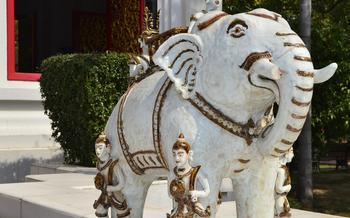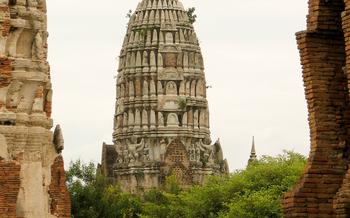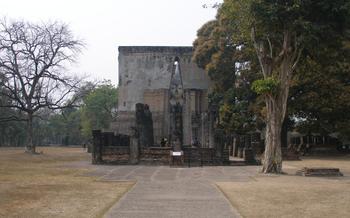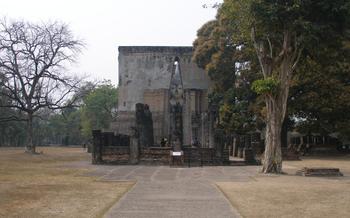
Wat Tai
- The Wat Tai in Ubon Ratchathani: A Sacred Haven
- Unveiling the Ancient Murals
- Exploring the Ubosot: A Sacred Chamber
- Discovering the Ordination Hall
- Exploring the Bell Tower and Drum Tower
- Strolling Through the Temple Grounds
- Interacting with the Local Monks
- Attending a Temple Festival
- Giving Back: Donations and Volunteer Opportunities
- Exploring the Surrounding Area
- Savoring Local Delights
- Respecting Temple Etiquette
- Capturing the Beauty: Photography Tips
The Wat Tai in Ubon Ratchathani: A Sacred Haven
Nestled amidst the vibrant city of Ubon Ratchathani, the Wat Tai stands as a testament to Thailand's rich cultural and religious heritage. Built in the 16th century, this ancient temple exudes an aura of serenity and spirituality, inviting visitors to delve into the depths of Buddhist traditions.
With its intricate architecture, stunning murals, and sacred Buddha images, the Wat Tai is a masterpiece of religious art and architecture. The temple's history is intertwined with the city's founding, serving as a spiritual center for the local community for centuries. As you step through the temple gates, you'll be greeted by a sense of tranquility, enveloping you in a sacred space where time seems to stand still.
The temple's design embodies traditional Thai craftsmanship, showcasing intricate carvings, colorful mosaics, and elegant stupas that reach towards the heavens. The ubosot, the temple's main sanctuary, is a sight to behold, adorned with magnificent murals depicting scenes from Buddhist mythology and the life of the Lord Buddha. The temple's serene atmosphere and spiritual significance make it a popular destination for pilgrims, worshippers, and tourists alike, seeking solace, inner peace, and a deeper connection to their faith.
Unveiling the Ancient Murals
The Wat Tai's ancient murals are a testament to the artistic prowess and spiritual devotion of the temple's founders. These intricate paintings adorn the walls of the ubosot and depict scenes from the life of Buddha, as well as stories from Thai mythology and folklore. The murals are not merely decorative but serve as powerful teaching tools, conveying Buddhist principles and moral lessons to the faithful.
The artists who created these murals employed various techniques to achieve depth, perspective, and realism. They used natural pigments derived from plants, minerals, and insects, creating a vibrant palette that has stood the test of time. The murals' intricate details and expressive figures bring the stories to life, immersing viewers in the rich tapestry of Buddhist art and culture.
Preservation efforts have been crucial in safeguarding these priceless murals. The temple authorities, in collaboration with art conservators, have undertaken meticulous restoration work to repair damage caused by age, humidity, and environmental factors. These efforts ensure that future generations can continue to appreciate the beauty and significance of these ancient masterpieces.
To gain a deeper understanding of the murals, I sought the insights of a local expert, Ajarn Somsak, a renowned scholar of Thai art and history. He explained the symbolism and iconography depicted in the murals, revealing the hidden narratives and spiritual messages embedded within each scene. Ajarn Somsak's knowledge and passion for the murals brought them to life, enhancing my appreciation for their artistic and cultural significance.
Exploring the Ubosot: A Sacred Chamber
The ubosot, also known as the ordination hall, is the most sacred building within the Wat Tai temple complex. It serves as a central location for important Buddhist rituals and ceremonies, including ordinations, chanting sessions, and meditation practices.
The architectural design of the ubosot is intricate and awe-inspiring, featuring a raised platform, a multi-tiered roof, and elaborate ornamentation. The interior walls are adorned with stunning murals depicting scenes from the Buddha's life and teachings, adding a vibrant and spiritual dimension to the space.
Inside the ubosot, one can find several Buddha images, each with its own unique symbolic meaning. The principal Buddha image, typically positioned at the center of the hall, represents the enlightened state of the Buddha and serves as a focal point for meditation and devotion.
Stepping into the ubosot, I felt a profound sense of peace and tranquility. The serene atmosphere, combined with the intricately designed interior, created a deeply spiritual ambiance. I spent a considerable amount of time observing the intricate details of the murals and contemplating the teachings they conveyed. The experience left me with a lasting impression of the temple's sacredness and the devotion of its followers.
Discovering the Ordination Hall
Purpose and Significance
Within the sacred grounds of Wat Tai, one cannot miss the imposing structure of the ordination hall, known as the sim. This hallowed chamber is imbued with profound significance in the Buddhist tradition, serving as the stage for one of life's most transformative rituals: the ordination ceremony. Here, young men and women embark on a spiritual journey, renouncing worldly attachments to embrace the path of enlightenment.
Architectural Features and Symbolic Elements
The ordination hall, adorned with intricate carvings and vibrant murals, stands as a testament to the artistry and devotion of the temple's builders. Its towering spires, reminiscent of celestial peaks, symbolize the aspirant's quest for spiritual elevation. Inside, the hall is adorned with sacred images and symbols, each imbued with profound meaning, guiding the ordinands on their journey towards enlightenment.
Rituals and Ceremonies
The ordination ceremony, conducted within the sim, is a solemn and sacred event, steeped in ancient traditions. Novices, clad in white robes, gather before the venerable monks, who guide them through the intricate rituals and precepts that mark their entry into the monastic order. Chanting, meditation, and the offering of alms create a deeply spiritual atmosphere, as the ordinands embrace their new path with unwavering dedication.
Personal Anecdote: Witnessing an Ordination Ceremony
I had the privilege of witnessing an ordination ceremony at Wat Tai, an experience that left an enduring impression on my soul. As I stepped into the sim, the air was thick with reverence and anticipation. The novices, their faces radiant with determination, prostrated themselves before the monks, who bestowed upon them the sacred robes and precepts. The chanting of mantras reverberated through the hall, creating a celestial symphony that transported me to a realm of tranquility and devotion. It was a profound reminder of the transformative power of faith and the unwavering commitment of those who seek enlightenment.
Exploring the Bell Tower and Drum Tower
Standing tall amidst the temple grounds, the bell tower and drum tower are iconic landmarks that hold significant religious and cultural value in the Buddhist tradition. Constructed with intricate attention to detail, these structures showcase the architectural prowess and artistry of the temple's builders.
The bell tower, with its graceful silhouette reaching towards the sky, houses a large bronze bell that resonates with a deep, sonorous tone. The bell is rung during important ceremonies and rituals to signal the start of prayers, call the monks to assembly, or mark special occasions. Its majestic sound reverberates through the temple grounds, creating a sense of awe and solemnity.
Adjacent to the bell tower stands the drum tower, its design mirroring that of its counterpart. Inside, a large cylindrical drum awaits its rhythmic awakening. Traditionally played in conjunction with the bell, the drum's steady beat provides a rhythmic accompaniment to the bell's deep tones. Together, they create a harmonious melody that echoes through the temple, inviting the faithful to prayer and meditation.
Beyond their functional role, the bell tower and drum tower serve as testaments to the temple's rich history and heritage. Their architectural design, with intricate carvings and decorative elements, reflects the artistic sensibilities of the era in which they were built.
Insider Tip: For an unforgettable experience, visit the temple during the early morning or evening hours. As the sun rises or sets, the golden hues cast a warm glow on the bell tower and drum tower, creating a magical ambiance that transports you back in time.
Strolling Through the Temple Grounds
As you wander through the temple grounds, a sense of tranquility washes over you. The lush gardens, adorned with vibrant flowers and meticulously trimmed trees, create a serene atmosphere that invites contemplation. Take your time to explore the various landmarks and features that dot the landscape. Admire the intricate carvings on the stupas, marvel at the towering chedi that pierces the sky, and find solace in the serene reflection of the temple's pond. Remember to observe respectful behavior and etiquette as you move through the sacred space, mindful of the monks and devotees who seek solace and spiritual fulfillment within these walls.
Once, as I strolled through the grounds, I stumbled upon a secluded corner where a group of monks were engaged in a lively discussion. Intrigued, I paused to observe them from a distance, careful not to intrude on their private moment. Their animated gestures and the sound of their laughter filled the air, creating a sense of camaraderie and joy that permeated the serene atmosphere. It was a glimpse into the lives of these dedicated individuals who had chosen a path of devotion and simplicity.
Interacting with the Local Monks
Engaging with the monks at Wat Tai is a unique opportunity to gain insights into Buddhism and Thai culture. These revered figures play a pivotal role within the temple community, dedicating their lives to spiritual practices and serving the local people. Visitors are welcome to approach the monks respectfully, seeking blessings, asking questions, or simply engaging in conversation. The monks are typically approachable and willing to share their knowledge and wisdom, offering a glimpse into the profound teachings of Buddhism.
One memorable encounter I had with a monk at Wat Tai left a lasting impression. As I sat in quiet contemplation, a monk approached me with a gentle smile. He introduced himself as Phra Ajaan and invited me to join him for a cup of tea. Over the next hour, we engaged in a fascinating conversation about Buddhist principles, the history of the temple, and the importance of mindfulness in daily life. Phra Ajaan's serene demeanor and profound insights left me feeling inspired and enriched.
Interacting with the monks at Wat Tai is an experience that goes beyond mere sightseeing. It is an opportunity for personal growth, spiritual exploration, and a deeper understanding of Thai culture. Whether you seek guidance, blessings, or simply a friendly conversation, the monks at Wat Tai are welcoming and ready to share their wisdom with open hearts.
Attending a Temple Festival
A Showcase of Culture and Devotion
Temple festivals are a vibrant display of Thai culture and devotion, offering a unique opportunity to immerse oneself in the local traditions. Held annually or on special occasions, these festivals attract both locals and visitors alike.
Processions filled with colorful floats, traditional music, and costumed performers create a lively atmosphere. The air is filled with the scent of incense and the sound of chanting as monks lead the processions, carrying sacred Buddha images.
During the festivals, the temple grounds transform into a bustling marketplace, with stalls selling a variety of local delicacies, handicrafts, and religious items. Visitors can savor the flavors of Thai street food, shop for souvenirs, and experience the vibrant energy of the festival.
Attending a temple festival is a chance to witness the deep-rooted Buddhist beliefs and practices of the Thai people. It is an opportunity to immerse in the local culture, embrace the festive spirit, and gain a deeper understanding of Thailand's rich heritage.
Personal Experience: A Memorable Celebration
I had the privilege of attending a temple festival during my stay in Ubon Ratchathani. The atmosphere was electric as the procession made its way through the temple grounds, accompanied by the rhythmic beats of drums and the melodious chanting of monks.
As the procession passed by, I was captivated by the intricate details of the floats, adorned with flowers, colorful fabrics, and mythical creatures. The energy of the crowd was infectious as everyone joined in the celebration, paying homage to the sacred Buddha images.
After the procession, I wandered through the bustling marketplace, sampling delicious local delicacies and browsing through the stalls filled with handmade crafts. The air was filled with the laughter and chatter of people enjoying the festive atmosphere.
Attending the temple festival was a truly memorable experience. It gave me a glimpse into the vibrant culture and deep-rooted traditions of the Thai people. It was a celebration of faith, community, and the beauty of Thai heritage.
Giving Back: Donations and Volunteer Opportunities
The Wat Tai, like many other temples in Thailand, relies on donations and volunteer support to maintain its sacred grounds and continue its spiritual and cultural activities. Visitors who wish to give back and contribute to the temple's upkeep have several opportunities to do so.
One way to support the temple is through monetary donations. Donations can be made in cash or through online platforms. These contributions help cover the costs of temple maintenance, renovations, and the support of the resident monks.
Another way to give back is through volunteer work. Volunteers can assist with various tasks around the temple, such as cleaning, gardening, and helping with temple events. Volunteering is a rewarding experience that allows visitors to immerse themselves in the temple community and contribute to its well-being.
Giving back to the Wat Tai is not only a way to support its physical upkeep but also a way to show gratitude for the spiritual and cultural experiences it offers. By contributing to the temple, visitors become part of its ongoing legacy and help ensure its preservation for future generations.
Personal Story:
During my visit to the Wat Tai, I had the opportunity to interact with several monks who shared their insights into the importance of donations and volunteer work. One monk explained that even small contributions can make a big difference in maintaining the temple and supporting the monks' daily needs.
Inspired by their words, I decided to make a donation to the temple. The process was simple and straightforward, and I felt a sense of fulfillment knowing that my contribution would help preserve this sacred space for years to come.
Exploring the Surrounding Area
Beyond the sacred confines of the Wat Tai, Ubon Ratchathani offers a wealth of attractions that beckon the curious traveler. A short stroll from the temple, history buffs can delve into the past at the Ubon Ratchathani National Museum, showcasing the region's rich cultural heritage through ancient artifacts and exhibits. Nature enthusiasts will find solace in the serene embrace of the nearby Nong Bua Daeng, a picturesque lake adorned with lotus flowers, offering tranquil vistas and opportunities for leisurely strolls.
Venturing further afield, the vibrant Ubon Ratchathani Night Market, a kaleidoscope of colors and aromas, awaits exploration. Here, visitors can indulge in a culinary adventure, savoring delectable local delicacies while immersing themselves in the lively atmosphere. For those seeking a unique perspective of the city, a leisurely bicycle ride along the scenic Mekong River promises breathtaking panoramas and a chance to connect with the local way of life.
Whether it's delving into the depths of history, communing with nature, embracing local culture, or simply reveling in the beauty of the surroundings, Ubon Ratchathani offers an array of experiences that complement the spiritual journey at the Wat Tai, ensuring a truly immersive and enriching travel experience.
Savoring Local Delights
The culinary scene around the Wat Tai is a testament to the vibrant culture and flavors of Ubon Ratchathani. As you explore the temple grounds, tantalizing aromas waft through the air, inviting you to indulge in the local delicacies.
Food stalls and vendors line the streets surrounding the temple, offering a tempting array of dishes to satisfy every palate. From fragrant bowls of khao soi, a northern Thai curry noodle soup, to grilled meats and sticky rice, the choices are endless.
For a taste of local flavors, try the som tum, a spicy papaya salad made with shredded green papaya, tomatoes, garlic, and chili peppers. The balance of flavors and textures in this dish is simply irresistible.
No visit to Ubon Ratchathani is complete without sampling the famous grilled chicken, known for its succulent meat and crispy skin. Paired with a side of sticky rice and a dipping sauce of your choice, this dish is a local favorite for a reason.
As you savor the local delights, remember to support the friendly vendors who make these culinary experiences possible. Your patronage not only satisfies your taste buds but also contributes to the preservation of traditional Thai cuisine.
In my personal experience, I had the pleasure of trying a unique dish called khanom krok, a coconut pancake made with rice flour and topped with sweet corn kernels. The fluffy texture and delicate sweetness of this dessert left me craving more.
Whether you're looking for a quick snack or a full meal, the culinary offerings around the Wat Tai will not disappoint. Embrace the opportunity to indulge in the local flavors and support the community's vibrant food culture.
Respecting Temple Etiquette
Visiting Buddhist temples is a sacred and respectful experience. As a traveler, it's important to be mindful of the local customs and etiquette to ensure a harmonious and respectful visit. At Wat Tai, proper attire is essential. Avoid shorts, tank tops, or revealing clothing. Opt for modest clothing that covers your shoulders and knees. When entering the temple grounds, remove your shoes and leave them neatly arranged outside.
When inside the temple, maintain a respectful demeanor. Avoid loud talking, boisterous behavior, or pointing at Buddha images. Remember that the temple is a place of worship, so be mindful of the monks and other visitors who may be engaged in prayer or meditation.
When making offerings to Buddha images, do so with a sincere and reverent attitude. Place your offerings gently and respectfully in front of the image. It's customary to offer flowers, candles, or incense sticks, but please be mindful of the temple's specific guidelines regarding offerings.
Finally, remember that the temple is not a tourist attraction but a place of worship and spiritual significance. Be respectful of the monks and other visitors, and avoid any behavior that may be disruptive or disrespectful. By following these simple guidelines, you can ensure a meaningful and enriching visit to Wat Tai.
Capturing the Beauty: Photography Tips
The Wat Tai's intricate architecture, vibrant murals, and serene atmosphere make it a photographer's paradise. To capture the temple's beauty, consider these tips:
-
Arrive early: The best light for photography is during the golden hours, shortly after sunrise or before sunset. Aim to arrive at the temple early to take advantage of the soft, warm light.
-
Explore different angles: Don't just stick to the same viewpoint. Walk around the temple, explore different angles, and look for unique perspectives. The temple's many levels and intricate details offer endless opportunities for creative shots.
-
Pay attention to composition: Consider the elements of composition, such as leading lines, symmetry, and negative space, to create visually appealing images. Experiment with different focal lengths and apertures to achieve the desired depth of field and focus.
-
Respect the temple's sacredness: Remember that the Wat Tai is a place of worship. Be mindful of the monks and other visitors, and avoid taking photos that may be disruptive or disrespectful. Always ask permission before photographing people, especially monks.
-
Capture the details: The Wat Tai is full of intricate details, from the delicate patterns on the murals to the ornate carvings on the pillars. Take your time to zoom in and capture these details, which often tell a story of their own.





